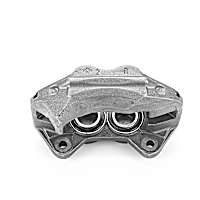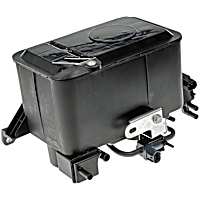Whether you’re buying the newest model or an older one, the Toyota 4Runner’s superb predicted reliability rating makes it a worthwhile investment. It boasts excellent off-road capabilities and advanced features that make it a great daily driver. Look forward to smooth drives with this dependable, high-performing SUV.
Are Toyota 4Runners Reliable?
The Toyota 4Runner has scored high on all major reliability ratings. RepairPal gave it 4.0 out of 5.0, ranking it 9th out of 26 in the midsize SUV segment.
The 2020 Toyota 4Runner received a reliability rating of 80 out of 100 from JD Power, achieving 4th place in its category. It also has a high resale value, with a rating of 94 out of 100. With proper maintenance and careful use, a 4Runner can last well past its estimated lifespan.
Top Toyota 4Runner Problems
Despite its reliability, the Toyota 4Runner has its fair share of issues. Listed below are the most widely reported problems for different 4Runner models:
Brake System Problems
The 2017 Toyota 4Runner has quite a few braking issues. Many owners have reported temporary failure and their brakes locking up for a short period on one side of the SUV. Similar problems were recorded in newer 4Runners, such as the 2014 and 2015 model years.
Braking problems are also notorious in 4th generation 4Runners, especially in the 2003-2005 model years. Many owners have complained about issues in the front brake calipers and front brakes, warping problems, and premature wear in the front brake rotor and brake master cylinder.

Automatic Transmission Problems
Automatic transmission issues are common in Toyota 4Runner models that were rolled out in 1990-2011 and 2016. Many owners have reported that their SUV reverts to manual shifting, won’t shift into overdrive, or won’t shift into drive at the initial start-up. Most of these problems lead to a loss of power and rough shifting.
The automatic transmission may not shift properly after 25,000-150,000 miles due to a shift solenoid that needs replacement or a faulty throttle position sensor. Most of the time, a complete overhaul is not necessary to resolve the issue.

Airbag Failure
Toyota recalled over 900,000 vehicles in 2019 to replace high-risk airbags, and the 2015 Toyota 4Runner was one of them. The model had potentially defective front airbag inflators, which may explode or fail to deploy during an accident. Either way, it can cause serious injury. So if you’re planning to get a 2015 4Runner, make sure that this problem has already been resolved.
Corroded Solenoid Contacts in the Starter
This is a common problem across the 3rd and 4th generations of Toyota 4Runners. Corroded solenoid contacts can result in the SUV suddenly stopping or refusing to start altogether.
Many owners have reported that the turn key and starter emit unusual ticking sounds when they attempt to start the vehicle. Most were able to resolve this issue by replacing a faulty starter. A starter solenoid replacement can cost you around $50 to $200 plus labor costs.
Charcoal Canister Failure
When the charcoal canister purge control solenoid valve fails, it can cause emission control problems that will trigger the check engine light. This could result in debris entering the evaporative emission (EVAP) system and causing emission control problems.
This problem is common in 4th generation 4runners, namely the 2004-2005 and 2009 model years. The 4Runner owners who experienced this issue had to replace the worn canister to fix it. A vapor canister replacement can cost you around $250 to $450 plus labor costs. A vapor canister purge solenoid may also be the reason behind this issue, and a replacement can cost you around $60 to $100 plus labor costs.

Rust/Corrosion and Body/Paint Problems
Rust and corrosion have been a huge problem for most 4th generation Toyota 4Runners, and they usually develop at around 154,000 miles. Many owners have reported that although their 2003 Toyota 4Runner has worked fine for years, a trip to the mechanic revealed that their vehicle had a severely corroded frame and suspension.
Meanwhile, severe undercarriage rusting is a common 2005 Toyota 4Runner problem. Owners have been told that their SUV was unsafe to drive because its underside had been badly corroded. Due to the volume of complaints, Toyota recalled and replaced these model’s affected parts. Fixing these body/paint issues can cost you as much as $1,800 plus labor costs.
Cracked or Melted Dashboard
Another common 2004 Toyota 4Runner problem is a sticky, melted, or cracked dashboard. This problem came up a lot for this specific model. Many owners have complained that their dashboards melted under the heat of the sun, forming a sticky, shiny substance in place of the plastic.

Cosmetic issues aside, the melted dashboard could prevent airbag deployment in case of accidents. Owners have also reported that the goo reflects an intense glare that could temporarily blind them and create dangerous driving situations. So Toyota recalled the affected vehicles and reimbursed the owners who already paid for their dashboard repairs.
Failed Mass Air Flow Sensor
Owners of 1996-2002 4Runners have reported this problem, though there have been similar complaints in 2012 models. Most complained about random cylinder misfires, hesitation, poor acceleration, buckling, stalling, and overall poor engine performance. When they took their SUV to get fixed, the problem was traced to a faulty mass air flow sensor.
This issue is usually resolved by either cleaning the sensor or replacing it with a new one. A mass air flow sensor replacement can cost you around $20 to $250 plus labor costs.
As long as you’re aware of the potential problems with the particular Toyota 4Runner model you’re planning to buy, choosing this SUV should come with little risk. If you’re looking to purchase a used 4Runner, look up the most common issues of the model that interests you. Make sure the seller took care of any problems before sealing the deal.
Products Mentioned in this Guide
Any information provided on this Website is for informational purposes only and is not intended to replace consultation with a professional mechanic. The accuracy and timeliness of the information may change from the time of publication.


 Brake Caliper
Brake Caliper
 Vapor Canister
Vapor Canister
 Mass Air Flow Sensor
Mass Air Flow Sensor
















Anybody have issue with lack of adequate illumination of the dashboard
Yes ! Replaced bulbs but still low illumination. Have had many Toyotya products, but aside from Engine reliability, the 4th Gen, maybe all 4 Runners have quality problems uncommon to other Toyotas. Clear coat flaking, chassis corrosion, cruise control, 4 WD electronic engagement control (Why not Manual ?) Differential issues, windshield wiper controls, paint in general. Are there quality control issues at this particular Plant that make it different from others ?
Question for all toyota fans/lovers. First ?, is what is the best brake pad & rotors for 2021 4runner Nightshade; since the Toyota service/repair are demanding at least $1000+. My brakes were already squeaking before the first year ran out.
2nd ?, is the car inspection for (emissions & state) included in the Toyota cares services?.
MY TOYOTA 4 RUNNER STALLS AND SOME TIMES WHEN I PRESS THE GAS PADLE NOTHING HAPPEN AS IF THE PADDLE DOES NOT WORK . AFTER 10 OR 15 MINUTES, IT WILL START AGAIN AS IF NOTHING HAPPEN. IT WILL STAAL 2-3 TIMES A DAY . WHAT COULD BE WRONG.